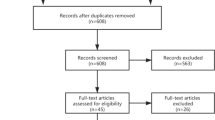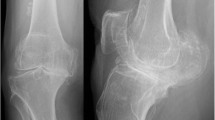Abstract
Purpose
Despite Total Knee Arthroplasty (TKA) being one of the most successful procedures for end stage arthritis, nearly 20% of patients undergoing this procedure remain dissatisfied. Various design options have been introduced to reduce this cohort of patients. One such option has been the introduction of the medial congruent (MC) polyethylene design. This study was undertaken to evaluate outcome measures and gait analysis in patients undergoing bilateral single stage TKA where the posterior cruciate ligament (PCL) was retained or excised in contralateral knees.
Methods
60 bilateral TKA’s were performed by a single surgeon using a MC design option from July to Sep 2021. The study lots included patients between the ages of 55 and 70 years with fixed varus deformity of degenerative aetiology, and Kellgren Lawrence Grade 3 and 4 radiological changes. Exclusion criteria were previous surgery to the lower extremities, sero positive arthropathies, post traumatic arthritis, valgus deformity, flexion contractures > 20°, and any pre-existing pathology impacting gait, e.g., poliomyelitis, or neuromuscular disorders. The PCL was retained or sacrificed on contralateral sides for the purpose of this study. Functional scores, outcomes and gait analysis on level and gradient walking were evaluated at a follow-up of 18 months.
Results
At 18, months the Range of Motion (ROM) improved from a preoperative value of 97.3 ± 11.5 to 110.3 ± 6.1 on the PCL retained side (MC-PCL) and from 96.5 ± 10.8 to 113 ± 5.8 on the PCL excised side (MC-PCLX). Knee Society Score (KSS-2011) improved from a preoperative value of 21.2 ± 4.5 to 89.8 ± 3.4 at 18 months postoperatively on the MC-PCL side and from 21.5 ± 4 to 88.2 ± 3.7 on the MC-PCLX side. Forgotten Joint Score (FJS-12) was 8.8 ± 0.7 on the MC-PCL side and 8.1 ± 0.9 on the MC-PCLX side 18 months after surgery. Our gait analysis evaluation demonstrated a lower forefoot pressure in the MC-PCL group in comparison to the MC-PCLX group when subjects were made to walk on a 30° upward incline. This difference was found to be statistically significant.
Conclusion
In this study, while ROM was greater in the MC-PCLX study lot, patient satisfaction was higher in the MC-PCL study lot. Gait assessment demonstrated lower forefoot pressure while ascending an incline of 30° in the MC-PCL study lot as compared to the MC-PCLX study lot approximating normal gait patterns.
Level of evidence
II.
Similar content being viewed by others
Data availability
Relevant data is available and can be provided on request.
Abbreviations
- TKA:
-
Total knee arthroplasty
- MC:
-
Medial congruent
- PS:
-
Posterior stabilizing
- CR:
-
Cruciate retaining
- PCL:
-
Posterior cruciate ligament
- ROM:
-
Range of motion
- KSS:
-
Knee society score
- OKS:
-
Oxford knee score
- FJS:
-
Forgotten joint score
References
Alesi D, Di Paolo S, Bragonzoni L, Pizza N, Zaffagnini S, Zinno R, Marcheggiani Muccioli GM (2022) No kinematical difference between ultra-congruent and medial- congruent total knee arthroplasty when implanted with mechanical alignment: an in vivo dynamic RSA study. Knee Surg Sports Traumatol Arthrosc 30(9):2975–2979
Batra S, Malhotra R (2022) Medial Ball and socket total knee arthroplasty in indian population: 5-year clinical results. Clin Orthop Surg 14(1):90–95
Blaha JD (2002) A medial pivot geometry. Orthopedics 25(9):963–964
Cacciola G, De Martino I, De Meo F (2020) Does the medial pivot knee improve the clinical and radiographic outcome of total knee arthroplasty? A single centre study on two hundred and ninety seven patients. Int Orthop (SICOT) 44:291–299
Calvisi V, Paglia A, Ciprietti N, Goderecci R (2018) Cruciate retaining total knee arthroplasty. In: Primary Total Knee Arthroplasty. pp 23–40
Canham CD, Incavo SJ (2018) The medial stabilized knee guides knee motion. Tech Orthop 33(1):52–56
Dall’Oca C, Ricci M, Vecchini E, Giannini N, Lamberti D, Tromponi C, Magnan B (2017) Evolution of TKA design. Acta Biomed 88(2S):17–31
Frye BM, Patton C, Kinney JA, Murphy TR, Klein AE, Dietz MJ (2021) A medial congruent polyethylene offers satisfactory early outcomes and patient satisfaction in total knee arthroplasty. Arthroplasty Today 19(7):243–249
Heckmann ND, Steck T, Sporer SM, Meneghini RM (2021) Conforming polyethylene inserts in total knee arthroplasty: beyond the posterior-stabilized and cruciate-retaining debate. J Am Acad Orthop Surg 29(22):e1097–e1104
Ho IJ, Hou YY, Yang CH, Wu WL, Chen SK, Guo LY (2010) Comparison of plantar pressure distribution between different speed and incline during treadmill jogging. J Sports Sci Med 9(1):154–160
Jones CW, Jacobs H, Shumborski S, Talbot S, Redgment A, Brighton R, Walter WL (2020) Sagittal stability and implant design affect patient reported outcomes after total knee arthroplasty. J Arthroplasty 35(3):747–751
Kato M, Warashina H, Mitamura S, Kataoka A (2023) Medial pivot-based total knee arthroplasty achieves better clinical outcomes than posterior-stabilised total knee arthroplasty. Knee Surg Sports Traumatol Arthrosc 31(3):998–1010
Konno T, Onodera T, Nishio Y, Kasahara Y, Iwasaki N, Majima T (2014) Correlation between knee kinematics and patellofemoral contact pressure in total knee arthroplasty. J Arthroplasty 29(12):2305–2308
Lee TQ (2014) Biomechanics of hyperflexion and kneeling before and after total knee arthroplasty. Clin Orthop Surg 6(2):117–126
Nedopil AJ, Shekhar A, Howell SM, Maury LH (2021) An insert with less than spherical medial conformity causes a loss of passive internal rotation after calipered kinematically aligned TKA. Arch Orthop Trauma Surg 141:2287–2294
Nishio Y, Onodera T, Kasahara Y, Takahashi D, Iwasaki N, Majima T (2014) Intraoperative medial pivot affects deep knee flexion angle and patient-reported outcomes after total knee arthroplasty. J Arthroplasty 29(4):702–706
Parcells B (2017) Native knee kinematics, basic concepts of total knee arthroplasty, Hip and Knee Book. Elsevier
Petersen ET, Rytter S, Koppens D, Dalsgaard J, Hansen TB, Andersen MS, Stilling M (2023) Medial congruent polyethylene design show different tibiofemoral kinematics and enhanced congruency compared to a standard symmetrical cruciate retaining design for total knee arthroplasty-an in vivo randomized controlled study of gait using dynamic radiostereometry. Knee Surg Sports Traumatol Arthrosc 31(3):933–945
Putame G, Terzini M, Rivera F, Kebbach M, Bader R, Bignardi C (2022) Kinematics and kinetics comparison of ultra- congruent versus medial- pivot designs for total knee arthroplasty by multibody analysis. Sci Rep 12:3052
Sabatini L, Risitano S, Parisi G, Tosto F, Indelli PF, Atzori F, Massè A (2018) Medial pivot in total knee arthroplasty: literature review and our first experience. Clin Med Insights Arthritis Musculoskelet Disord 11:1179544117751431
Shi W, Jiang Y, Wang Y, Zhao X, Yu T, Li T (2022) Medial pivot prosthesis has a better functional score and lower complication rate than posterior-stabilized prosthesis: a systematic review and meta-analysis. J Orthop Surg Res 17:395
Sun X, Gao X, Sun X, Su Z (2021) Comparison of clinical and radiographic results between total knee arthroplasties using medial pivot and posterior-stabilized prosthesis: a meta-analysis. Medicine 100(4):e23809
Van Overschelde PP, Fitch DA (2016) Patient satisfaction at 2 months following total knee replacement using a second generation medial-pivot system: follow-up of 250 consecutive cases. Ann Transl Med 4(18):339
Wang Z, Zhang YQ, Ding CR, Wang YZ, Xu H (2021) Early patellofemoral function of medial pivot prosthesis compared with posterior stabilized prosthesis for unilateral total knee arthroplasty. Orthop Surg 13(2):417–425
Youm YS, Cho SD, Lee SH, Cho HY (2014) Total knee arthroplasty using a posterior cruciate ligament sacrificing medial pivot knee: minimum 5-year follow-up results. Knee Surg Relat Res 26(3):135–140
Acknowledgements
Nil.
Funding
This study did not require any funding.
Author information
Authors and Affiliations
Contributions
AR- study concept, design and editing. SK and KA (PT)- writing original draft- review and editing. MKS- data curation.
Corresponding author
Ethics declarations
Conflict of interest
The corresponding author receives Royalties from Zimmer Biomet and Meril. No other author has any conflict of interest.
Ethical approval
The study was approved by the Medanta Institutional Review Board.
Informed consent
Informed consent was taken from all the patients.
Additional information
Publisher's Note
Springer Nature remains neutral with regard to jurisdictional claims in published maps and institutional affiliations.
Rights and permissions
Springer Nature or its licensor (e.g. a society or other partner) holds exclusive rights to this article under a publishing agreement with the author(s) or other rightsholder(s); author self-archiving of the accepted manuscript version of this article is solely governed by the terms of such publishing agreement and applicable law.
About this article
Cite this article
Rajgopal, A., Kumar, S., Singh, M.K. et al. PCL retention demonstrates better functional scores and gait patterns in total knee arthroplasty using a medial congruent insert—a prospective study. Knee Surg Sports Traumatol Arthrosc 31, 4741–4746 (2023). https://doi.org/10.1007/s00167-023-07499-5
Received:
Accepted:
Published:
Issue Date:
DOI: https://doi.org/10.1007/s00167-023-07499-5




